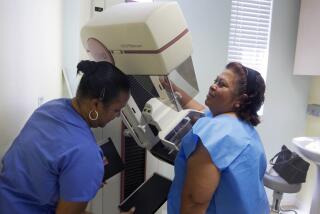The lessons to be learned from the ‘Mammography Wars’
- Share via
For those of you who are still worked up by last year’s recommendation that routine mammograms begin a decade later and be done less frequently, we recommend this essay being published in Thursday’s edition of the New England Journal of Medicine.
In “Lessons from the Mammography Wars,” two physicians from the University of Michigan in Ann Arbor remind both doctors and patients that the change advocated by the U.S. Preventive Services Task Force was not that dramatic – instead of screening all women for breast cancer as soon as they hit 40, women between the ages of 40 and 49 should make individual decisions with their doctors and widespread screening should start at age 50. They also suggested that mammograms be done every two years instead of annually.
The reason for this is that mammograms – like most other kinds of tests and treatments – are not equally useful for all people. Some people (in this case, older women with a higher risk of breast cancer) will benefit more, while others (younger women) will benefit less. That’s why the “cost” of preventing one breast cancer death for a woman in her 40s is to perform more than 20,000 mammograms on more than 1,900 women, resulting in about 2,000 false positives. By contrast, the “cost” of preventing one breast cancer death for a woman in her 60s is 5,000 mammograms for 400 women, resulting in 400 false positives.
“When either side in the mammography wars claims that the evidence suggests that women should or should not undergo routine mammography starting at the age of 40 years, they are deceiving themselves and the public about what the evidence can tell us,” write Dr. Kerianne H. Quanstrum and Dr. Rodney A. Hayward. “They are really just making different value judgments about where to set the threshold.”
Quanstrum and Hayward also explain why it is easier to say that mammography should be used more than to say it should be used less. “If experts shout loudly that every woman 40 years of age or older must be screened annually for breast cancer, then breast cancer must be important, screening must be a basic human right, and doctors who provide this service must have great value and authority,” they write. Once women believe this, it’s no wonder they would object to the notion that they should get fewer mammograms.
And, as the authors point out, it’s not like the doctors encouraging women to ignore the PSTF’s advice are neutral observers. The doctors may believe that they are acting for the good of their patients. But they also stand to lose a lot of money if the number of mammograms is cut in half.
“In any other industry, we accept the idea as natural that those providing a service or product hold their own and their shareholders’ interests as a primary objective,” Quanstrum and Hayward write. “Why have we failed to acknowledge that the same phenomenon occurs in health care?”
The entire essay is online here.
-- Karen Kaplan/Los Angeles Times






